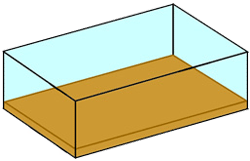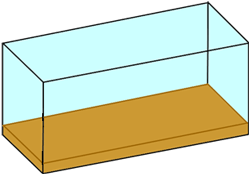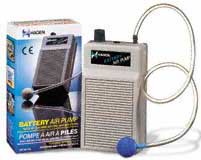Tropical Fish Setup Shortcuts
15 years ago, I had several tropical fish tanks. I got my info from the store staff, and I was constantly having problems. My father got me a good book on the subject, and then the problems stopped. I Kept fish for a few years.
Over the last few years I got out of the hobby and moved around. But now I'm getting settled again, and got back into tropical fish. I don't have the book anymore, and I had forgotten some of what I knew, did some research on the net, went back to a store and went through some growing pains again. (Not as many this time!) I do know most of this info is on the net at various sites, but there is some info you just can't find. (At least I didn't!)
Anyway, I'm not here to do a comprehensive page on tropical fish, I just want to fill in any blanks that I couldn't find doing hours of searching on other web sites.
Then I found out one of the guys I online game with, was a tropical fish breeder, has 48 tanks in his house, and has won many awards. Unreal huh?
You wanna talk about a good source of information with no ulterior motives.
So here's some information to a setup for tropical freshwater fish (haven't done marine yet!), and keep you from spending more money then you need to spend.
For starters, be wary of what the stores tell you. As much as they know (fish store staff) they are still out to make money.
Get the biggest tank that you can afford but remember that a set up tank will weigh about 10 lb. per gallon. Water weighs about 8.3 lb./gal, plus the weight of the glass, plus all the gravel, plus any other driftwood and/or rocks. Make sure your floor will withstand the weight.
So, one of my tanks, (the 38 gallon) should weigh 38 gal * 8.3 lb. per gallon + 50 lb. for gravel + 25-30 lb. for the tank itself = about 390 - 395 lb. for the total tank. A decent way to do a rough estimate.
Tanks:
A tank with a wider floor area is a healthier tank.
For an example lets say the two diagrams of tanks to the right are both 50 gallon tanks. Tank 1 will be the healthier tank because it has more of a 'floor' area.
Tank 1 is also a more expensive tank to buy. Nice huh?

Tank 1

Tank 2
Tank 2 is better at display, though. I guess it depends on what you want. My 38 is a tall and somewhat thin, like tank 2, but the environment would be more stable with the design like tank 1.
The rule of thumb when filling your tank with fish is one inch of fish per gallon. So if you have a 10 gallon tank, and you get 5 - two inch fish, your tank is max-ed out. If you have a 30 gallon tank, you can get 30 -one inch fish, or 10 - three inch fish and so on...
Be advised, don't max out your tank right to the hilt. You have taken up room with gravel, and any other ornaments like rocks or driftwood. Also, the tank won't need quite as much care if you don't max it out and it will stay healthier. With my 38, I only added about half the allowed amount of fish. Much easier to deal with. The environment stays more stable.
One of the things you may be told is set up your tank, and then after about 4 days to a week, you can get some of your fish and your plants. That's too soon for the fish. You should wait at least a month and a half before getting all your fish.
Another thing that puts me off is that the store could very easily treat their plants for snails, but some don't because they said they didn't keep plants long enough to treat 'em.
The store staff will give you lots of info on community fish, schools, and loners, so I'm not going to get into this area too much. Do your homework on what kind of fish you want.
If you want a suggestion, I'd recommend White Cloud Mountain Minnows. They like cooler temps, they don't get sick easily, they don't get stressed easily, eat almost any fish food, are small so you can get a good amount (Prefer to kept in school) for even smaller tanks, they are good in a community tank, and they are beautiful little fish. They grow 1" to 1.5 inches.
Photo of a White Cloud Mountain Minnow.
Guppies are also a good beginner fish. Very easy to breed.
If you go with Neon Tetras, (or Black Tetras for that matter), which seem to be a favorite, remember that the get stressed real easy, get sick easy, don't like large water changes, don't like any drastic changes of any kind. I'm told they like salt in the water, but I find they just get ick. I have tried to add salt slowly (Total of 2 tablespoons for 38 gallons), taking about 3 days to add it, but I still end up with ick spots.
If you do use salt, add half of what is suggested. That's usually about 1 tablespoon per 5 gallons of tank water. I put in 1 tablespoon per 10 gallons of water.
Depending on what kind of fish you get, consider getting one or two little Freshwater shrimp for the tank (as long as you have smaller fish or fish that won't eat the shrimp). They are awesome. They don't bother any fish at all, they eat up algae, leftover fish food, decaying plant parts, whatever, and their feces is easy to vacuum up when doing a water change. These little suckers are working 24/7.
I have 2 in my 38 gallon tank and 1 in my 10 gallon tank.
A macro photo (Taken by me) of one of my ghost shrimp. He's cool huh? And just over an inch in length.
Plants
Get real plants for your tank. It will keep the tank much more healthier.
Whatever plants you get, try to stick with the easy to grow ones at first.I would recommend Java Moss (Vesicularia dubyana) if you want a tank full of plants in no time or if you are gonna try breeding This plant grows with no problems, is easy to take care of, and cuttings grow right away. Java Moss is like bamboo, grows soo fast, it will overtake the tank in no time.
Mexican Oak Leaf is easy to grow, cuttings will grow right away, but it won't overpower the tank like Java Moss will. It will grow long across the top, instead of growing in a bunch. I am also seeing how well Limnophila sessiliflora does. It's a really nice fern.
Here's a recommended set up plan:
- Keep oil, soap and any soap residue away like the plague.
- After the treatment is done, do a 35-50% water change, replace the charcoal, add your water treatment and bio support and a bit of salt if you use it in your water.
- Two or three days after this water change, you could get ghost shrimp and maybe even a few (2-5) small starter fish, like feeder guppies.
- Now, run your tank for at least a month and a half and don't do any water changes.
- After all this, then start getting your desired fish.
- Add the fish slowly. Float them in the bag in the tank, add water to the bag, from the tank over the next 15 - 20 minutes. Then, if you don't want the store water in your tank, net the fish out carefully. Another way to do this is with a small isolation tank (about 10 gallon) then you can keep the new fish in the isolation tank for about 2 weeks, then switch 'em to the main tank.
- The least stressful way to transfer fish a short distance, is to turn off the lights, wait about an hour, then carefully and gently corral them into the net (Don't chase them with the net!), gently lift them out and into the main tank. After transfer of fish is complete, wait an hour, then bring the lights back on.
- Just in case the power goes out, I also have a a UPS (battery backup) for a computer for when the power goes out. My Tetra® Whisper® Power filter 10 uses 4 watts of power and my Aquaclear® 300 filter uses 7 watts of power. I got an APC 500 (Back-UPS ES 500VA 120V ) set up to backup the filters only, and with the total wattage being 11 watts for both the 10 gallon and the 38, I should get 155 minutes or just over 2.5 hours. (I ran it for about 2 hours and 40 minutes, and it was still going strong.) The only problem is the sucker beeps every 20 - 30 seconds, and it gets annoying.
Maintenance (Always rinse your hands with just tap water before touching anything related to the tank) :
- Gently rinse the mechanical filter only if it's getting really gummed up, but not the bio wheel. Place the bio wheel in tank.
- If the filter is a sponge, don't rinse it for 2 or 3 months. When you do rinse the sponge, use some tank water in your water change bucket, and gently shake it in this water to rid sponge of heavy, loose debris. Then put sponge back in filter. Don't rinse sponge with tap water, squeeze it out alot, and do not do this on the same day as a 25% water change. Just take a small amount of water to gently rinse the sponge. Discard this water.
- Change 25% water every week. If you have fussy fish, do 10% twice a week. Not on the same day as the sponge rinse.
Major Don'ts:
- Don't add the ghost shrimp when treating the tank with Snail-A-Way (Copper Salts). It's possible it may kill them. (Also some algae eaters like a Pleco could die from it. Killed one myself treating a tank with Copper Salts) Get them at least a few days after all the treatments are done and a 25% water change.
- Don't use chemical pH changer of any kind. Regardless of how safe it claims to be. If you want to make the water more acidic, use Peat moss or pellets. Best to keep it at a neutral pH.
- Don't overfeed your fish! Their bellies are the size of their eye, and not only will the stuff themselves, (not good for fish) the rotting food will raise the pH. Give them what they will eat within 30 seconds.
- Don't get a crayfish. All your fish will be gone, and he will be fat.
- Don't let the Ammonia levels show. When testing the water, make sure levels are always at 0 PPM. If a test shows ammonia levels, do a water change.
Moving fish over long distances by Car.
What if you gotta move, but you wanna keep your fish?
Best thing to do is get a 5 gallon bucket, get a battery powered airpump, and run it during the drive.
For the first month, you wanna do some drastic water changes to get the fish used to it. Change at least 20 - 30 percent once a week. I used 3 - 5 gallon buckets that I got from a wine making shop. The come with re-sealable lids with rubber seals in the lids. I poked holes in the lid, closer to the edge with a phillips screwdriver for the airhose. You may not want to seal the holes because a bit of air pressure will build up in the bucket, and then the pumps will work harder. I just kept the air hose holes a bit loose, so air could escape.
Use only the water from the fish tank and don't take it from the bottom. You may get some of the crap.
Don't feed your fish the day before the trip. They will travel better.
I used the Hagen battery powered airpump shown left.
Not made very well, switches are fussy, and battery (2 D cells) contacts and wells seem like it was made from a cheap project box from a cheap electronic supply store. It did however last about 7-8 hours before it seemed like I should change the batteries. Don't try to use any other air stones then what is supplied with the pumps. You can use longer and softer hose though. I used about 5 - 6 feet of hose. Just be careful you don't bend or crimp the hose and the air gets cut off. I taped the pumps to the top of the lid, about middle, and circled it with the hose.
I also floated my plants in the buckets with the fish to make them more at ease. That worked really well.
I put my gravel in a separate bucket.
We drove for about 14 hours, stopping a few times and I changed the batteries about half way through. When we got to a Bed and Breakfast, I hooked up the electric airpump for overnight, then got to our place. I tried to make sure the temperature stayed as constant as possible.
I rinsed in clean tap water (not washed!): the tank, gravel, body of filter, intake tubes, charcoal, ammo chips.
I used some fish water to rinse the sponge and discarded this water. I also used Bio-support and dribbled some all over the sponge, let it drip through, then put the filter together. I ran it from a bucket just in case some of the bacteria had died, and I didn't want to poison the tank. (If the good bacteria dies, it becomes toxic, and can poison the tank and kill the fish.) I ran it from the bucket full of clean water for about 10 minutes, then changed the water, did it again, then put the filter into the tank.
I put the water I transported the fish in, back into the newly set up tank. It was only 5 gallons worth from my 38 gallon, but better than nothing.
Over a 14 hour drive, then overnight, then another short drive, then had to wait for movers to finish, then get the tank set up and running. The water was a bit cloudy, so I ran it for a few hours. Finally into the tank 4 hours later, when the tank was starting to settle down, I returned the fish to their tanks.
Out of 3 Black Neons, 7 white clouds, one sword tail, 2 catfish, and 2 Kuhli loaches, only one Black Neon Tetra died.
Some good sites I found:
http://www.bigalsonline.com/splash.html
http://badmanstropicalfish.com/2ndpage.html
A big thanks goes to John in Texas.


